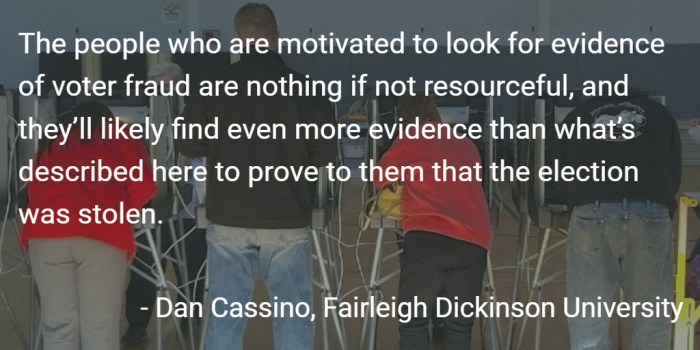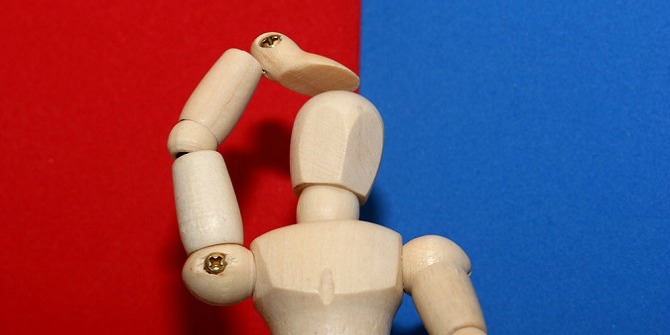 With his fortunes flagging in the polls, GOP presidential candidate Donald Trump has increasingly spoken of the 2016 election as being ‘rigged’. Dan Cassino looks at how ‘evidence’ of voter fraud might begin to circulate on and after Election Day; evidence which will be fueled by misunderstandings over exit polls, precinct sizes, and how election results are recorded.
With his fortunes flagging in the polls, GOP presidential candidate Donald Trump has increasingly spoken of the 2016 election as being ‘rigged’. Dan Cassino looks at how ‘evidence’ of voter fraud might begin to circulate on and after Election Day; evidence which will be fueled by misunderstandings over exit polls, precinct sizes, and how election results are recorded.
The 2016 US Presidential election will not be stolen. The decentralization of the system and the many layers of oversight and control mean that any attempt to engage in voter fraud widespread enough to impact the result is doomed to failure. That reality, however, won’t stop many Americans from believing that it was rigged, and the past gives us a good indication of exactly what the “evidence” of vote rigging will look like.
It’s important to start off by noting that Americans are generally open to believing that voter fraud is widespread. In a 2013 PublicMind poll, 23 percent of Americans (and 37 percent of Democrats) said that it was “probably true” that President Bush’s supporters stole the election in Ohio in 2004; almost identical numbers of Republicans said the same about President Obama in 2012. For whatever reason – motivated reasoning, a willingness to believe in the nefariousness of political opponents, lack of social contact with members of the other party – Americans commonly believe that our elections are rigged, even without a major party candidate encouraging such beliefs, as Republican nominee Donald Trump has done.
Because of this predisposition, it’s likely that “evidence” of voter fraud will begin to circulate on Election Day, and continue to swirl around the internet for weeks and months afterwards, fueling beliefs that the likely winner, Democrat Hillary Clinton, is illegitimate, and hardening opposition to her. The first piece of evidence that’s likely to be used to demonstrate fraud is early exit polls. While exit poll results from the consortium funded by the major news outlets aren’t officially released until after the polls close (in order to avoid influencing voters), the first data from them is released around 11 AM on Election Day. This data isn’t supposed to be made public, but at least some results from it generally leak. These results will, in some cases, be very different from the official vote tallies, and those differences will be taken as proof that the election was stolen. After all, if the early exit polls show Trump winning in Ohio by 5, and he winds up losing by 3, either the exit polls or the vote must be wrong, right?
Such “evidence” is mostly the result of misunderstanding how exit polls work. Exit polls, unlike most surveys, are not designed to be representative of voters. Rather, they sample precincts which have served as good indicators in the past, with the results then carefully weighted in order to project results for a state as a whole. In addition, early exit poll results only include voters who go to the polls in the morning, a group which is disproportionately Republican. All of this, of course, is in addition to the fact that exit polls cannot include the increasing number of voters who vote early, or by mail.

But exit polls won’t be the only evidence mustered to show that the election was stolen. A recurring talking point in this election has been precincts – mostly in Philadelphia, but in Chicago as well – that recorded literally no votes for Mitt Romney in 2012. A precinct can include a lot of people, and the precincts (technically called “divisions” in Philadelphia) in question, while strongly Democratic leaning, do include some registered Republicans, so the fact that no one voted for Romney in these precincts is seen as evidence that some malfeasance must have taken place. It’s to prevent just this that Trump has been urging supporters to keep an eye on polling places in Philadelphia to “make sure that this election is not stolen from us.”
As it turns out, however, the precincts in questions are relatively small, and the few Republicans registered in them, when contacted by reporters, either didn’t vote, or didn’t know that they were registered as Republicans. Given that Trump has single-digit support among African-Americans nationwide, and the number of precincts operating in heavily non-white inner cities; it would be rather surprising if there weren’t any that didn’t cast ballots entirely for Clinton.
A third source of evidence will be misunderstanding of how election results are recorded and reported in many areas. The US is a hodgepodge of different balloting and election systems, and the way in which some are reported can cause confusion. For instance, in 2012, St. Lucie County, Florida (in east central Florida, north of Palm Beach) had 175,000 registered voters, but reported almost 250,000 votes were cast. It’s not a particularly Democratic county, but this seems a clear sign that something was going on here.
Of course, another thing going on is weird ballot design. St. Lucie County, along with several others across the Southern US, makes use of a multi-page ballot, in which each page of the ballot is counted separately by the tallying system. In the 2012 general election, the ballot had two pages, so each completed ballot was counted as two votes. Rather than 142 percent voter turnout, the county had something like 71 percent turnout: high, but certainly not impossible.
The people who are motivated to look for evidence of voter fraud are nothing if not resourceful, and they’ll likely find even more evidence than what’s described here to prove to them that the election was stolen. And the elections will be fixed, in a way: through voter identification requirements, registration deadlines, felony disenfranchisement laws, gerrymandering, restrictions on ballot and debate access for independent candidates, and so. This sort of real rigging is widespread, and entirely public: but that’s not likely to stop some partisans from continuing to dig up false evidence of a stolen election that allows them believe that they didn’t really lose.
Featured image credit: Dan Kennedy (Flickr, CC-BY-NC-SA-2.0)
Please read our comments policy before commenting.
Note: This article gives the views of the author, and not the position of USAPP – American Politics and Policy, nor the London School of Economics.
Shortened URL for this post: http://bit.ly/2eIerX5
_________________________________
 Dan Cassino – Fairleigh Dickinson University
Dan Cassino – Fairleigh Dickinson University
Dan Cassino is an associate professor of Political Science at Fairleigh Dickinson University in Madison, New Jersey, who studies political psychology and polling. His most recent book, “Fox News and American Politics,” was released in April.






